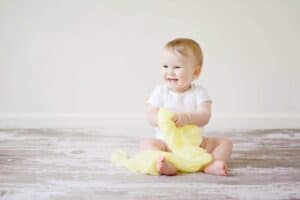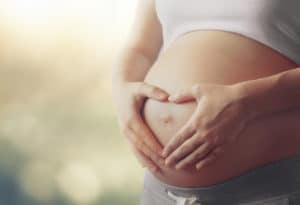The U6 examination is the so-called “one-year examination” and is the last preventive examination in infancy. When exactly is the U6 examination performed? Why is the U6 so important? What is actually done and tested? Can a baby “fail” the tests? Are vaccinations given?
Here you will find answers to your questions.
Table of contents
When Does The U6 Examination Take Place?
The U6 examination takes place when your baby is between 10 months and 1 year old and should be attended in any case, as any developmental abnormalities or illnesses can be detected at an early stage and treated if necessary.
In addition, you as a mother can ask the attending pediatrician questions, if you have any.
What Is Examined During The U6 Examination?
Before the pediatrician performs the U6, your baby will be measured and weighed and the head circumference will be measured. The baby will be naked except for the diaper. The following examination will also be unclothed. The rooms are usually well-tempered so that the baby does not freeze.
Before the actual examination of the baby, a so-called anamnesis takes place, in which the pediatrician asks you about general topics. Nutrition, sleeping and the care situation are important topics. Bowel movements (e.g. frequency of diarrhea), illnesses and frequent infections will also be discussed.
In addition, the pediatrician will ask you about speech comprehension. A baby who is 10 months old should understand prohibitions (even if they are quickly forgotten and have to be repeated). Another question is whether your baby likes to play hide-and-seek at 10 months or hides things himself under a blanket, for example, and then uncovers them again.
As in the previous U examinations, the pediatrician examines your baby’s entire body as well as his or her cognitive abilities and social skills.
U6 Examination: What Is Examined
Body
Abnormal skin, injuries, undescended testicles, hernias in the groin.
Organs
Heart and lung function, bowel sounds.
Gross And Fine Motor Skills
Sitting freely, pulling up on furniture, standing briefly, grasping with two fingers.
Reflexes
Support when falling to the side.
Speech
Hoarseness, utterance of two-syllable sounds.
Perception/Cognition
Implementing simple requests (e.g. giving something), tracking objects with the eyes.
Social/Emotional Competence
Distinguishing between familiar and unfamiliar people, enjoyment of familiar people, enjoyment of playing and hiding, independent exploration of surroundings.
Communication
Responding to speech, seeking contact with caregivers by oneself.
Vision plays an important role in the development of many skills. Therefore, special attention is also paid to this. It is tested whether the baby can follow an object or a light source with the eyes and how the pupil reaction is.
The sense of hearing is usually tested with a rattle. The baby does not see the rattle and should turn its head in the direction of the sound. If your baby is already 10 months old and does not do this at U6, your baby may be too excited and overwhelmed in this situation. If your baby turns to sounds at home with no visible source, tell the pediatrician.
Other Skills That Should Be Mastered At The Time Of The U6 Examination
- By the time a baby is 10 months old, it can crawl and is confident with crossed coordination.
- It should also recognize its name with confidence.
- After drinking with help is often accomplished at 10 months, a baby starts eating on his own (without cutlery) at 11 months.
- A baby at 1 year of age begins to pull himself up on objects or nursery furniture and to walk around them with his first steps.
What Consultations Take Place At The U6 Examination?
The pediatrician will advise you on the following things.
- Nutrition.
- Dental health and caries prophylaxis.
- Rickets prophylaxis.
- Vaccinations.
When your baby is 10 months old, he or she will already have the first teeth that need to be cared for. You will be advised whether it is advisable to give fluoride. In addition, the further administration of vitamin D will be discussed. The pediatrician can also advise you on ways to develop the child’s skills.
What Do You Need To Bring To The U6 Examination?
Bringing the U-Heft is very important so that the pediatrician can document everything. This is not only useful for recording the development of your baby, but also in the event of an accident, for example.
In this way, even unknown doctors can immediately recognize the development and vaccination status of your baby and treat him accordingly in the best possible way. A fully completed U-book is also helpful when changing pediatricians.
Why Is The U6 Examination So Important?
Every U examination is equally important. A baby will go through many developmental stages before he or she is 1 year old. As a parent, you have the best overview of your baby’s behavior and development.
But the pediatrician is in the best position to assess whether certain behaviors or bodily functions are not developed appropriately for the age of the baby and whether illnesses are present. To detect developmental delays as early as possible, it is important to attend all U examinations, including U6.
The earlier a delay or disease is detected, the better it can be treated.
Are Vaccinations Given At The U6 Examination?
Whether vaccinations are given at the U6 examination depends on many factors, e.g. whether your baby is already 11 months old or has been ill in the last few weeks, and the previous vaccinations. Therefore, you should discuss this in advance with your pediatrician. When which vaccination is due, you can read here.
What Does The U6 Examination Look Like For Premature Babies?
The U6 examination is performed for a premature baby in the same way as for a normal baby who is 10 months old. The attending pediatrician will take the adjusted age into account during the U6 examination.
What Happens If Not All Tests Are Passed?
Not every baby “passes” all the tests at the U6 examination. During the first year of life, developments are gone through most rapidly. There is no set order of when which skill must be mastered.
Each baby develops at his or her own pace. Just because a baby can’t sit up freely or crawl properly at 1 year old doesn’t mean he or she is developmentally delayed.
Only when multiple tests show abnormalities may there be a need for treatment. On average, a baby crawls when it is 10 months old. However, in some cases, this developmental step is not reached until 15 months and before that, the baby crawls on its stomach.
This is also part of healthy development. The tolerance limits for most developmental steps are very large.
What Happens If You Miss The U6 Examination?
The U6 examination has a large time window. You can take it when your baby is 10 months old or when your baby is already 1 year old. On average, the U6 examination takes place when a baby is 11 months old. The tolerance range of the U6 is between the 9th and 14th months.
After the 14th month, the U6 examination is no longer covered by health insurance and must be paid for as an Igel service. Tip: in order not to miss the U6 examination, make the appointment already when you take your baby to the U5!
If you notice something before the U6 examination or have specific questions, you can note it in the U-booklet. This way, it cannot be forgotten during the U6 examination.










